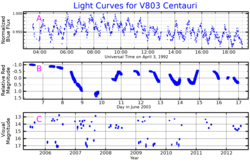 Three light curves for V803 Centauri, on three timescales, hours (plot A), days (plot B) and years (plot C). Adapted from Patterson et al. (2000), Kato et al. (2004) and Levitan et al. (2015) | |
| Observation data Epoch J2000.0 Equinox J2000.0 | |
|---|---|
| Constellation | Centaurus |
| Right ascension | 13 23 44.54 |
| Declination | −41° 44′ 29.54″ |
| Apparent magnitude (V) | 13.2 (var) |
| Characteristics | |
| Spectral type | pec |
| U−B color index | -0.9 - -1.0 |
| B−V color index | 0.0.1 |
| Variable type | AM CVn |
| Astrometry | |
| Proper motion (μ) | RA: -3.907 mas/yr Dec.: +11.978 mas/yr |
| Parallax (π) | 3.4885 ± 0.0599 mas |
| Distance | 930 ± 20 ly (287 ± 5 pc) |
| Absolute magnitude (MV) | 5.93 |
| Details | |
| White dwarf | |
| Mass | 0.9-1.2 M☉ |
| Donor star | |
| Mass | 0.06-0.11 M☉ |
| Other designations | |
| V803 Centauri, V803 Cen, AE-1, 2MASS J13234454-4144294, AAVSO 1317-41. | |
| Database references | |
| SIMBAD | data |
V803 Centauri (V803 Cen) is a cataclysmic binary consisting of a dwarf helium star losing mass to a white dwarf. It is an example of the AM Canum Venaticorum (AM CVn) type of cataclysmic variable stars.
References
- ^ Patterson, Joseph; Walker, Stan; Kemp, Jonathan; O'Donoghue, Darragh; Bos, Marc; Stubbings, Rod (2000). "V803 Centauri: A Helium-rich Dwarf Nova". Publications of the Astronomical Society of the Pacific. 112 (771). The University of Chicago Press on behalf of the Astronomical Society of the Pacific: 625–631. Bibcode:2000PASP..112..625P. doi:10.1086/316561. JSTOR 316561.
- Kato, Taichi; Stubbings, Rod; Monard, Berto; Butterworth, Neil D.; Bolt, Greg; Richards, Tom (March 25, 2004). "V803 Centauri: Helium Dwarf Nova Mimicking a WZ Sge-Type Superoutburst". Publications of the Astronomical Society of Japan. 56: S89 – S98. arXiv:astro-ph/0307308. Bibcode:2004PASJ...56S..89K. doi:10.1093/pasj/56.sp1.S89.
- Levitan, David; Groot, Paul J.; Prince, Thomas A.; Kulkarni, Shrinivas R.; Laher, Russ; Ofek, Eran O.; Sesar, Branimir; Surace, Jason (January 2015). "Long-term photometric behaviour of outbursting AM CVn systems". Monthly Notices of the Royal Astronomical Society. 446 (1): 391–410. arXiv:1410.6987. Bibcode:2015MNRAS.446..391L. doi:10.1093/mnras/stu2105.
- ^ Vallenari, A.; et al. (Gaia collaboration) (2023). "Gaia Data Release 3. Summary of the content and survey properties". Astronomy and Astrophysics. 674: A1. arXiv:2208.00211. Bibcode:2023A&A...674A...1G. doi:10.1051/0004-6361/202243940. S2CID 244398875. Gaia DR3 record for this source at VizieR.
- Samus', N. N.; Goranskii, V. P.; Durlevich, O. V.; Zharova, A. V.; Kazarovets, E. V.; Kireeva, N. N.; Pastukhova, E. N.; Williams, D. B.; Hazen, M. L. (2003). "An Electronic Version of the Second Volume of the General Catalogue of Variable Stars with Improved Coordinates". Astronomy Letters. 29 (7): 468. Bibcode:2003AstL...29..468S. doi:10.1134/1.1589864. S2CID 16299532.
- ^ Elvius, A. (1975). "Variable blue object with a peculiar spectrum". Astronomy and Astrophysics. 44: 117. Bibcode:1975A&A....44..117E.
- ^ Solheim, J.-E. (2010). "AM CVn Stars: Status and Challenges". Publications of the Astronomical Society of the Pacific. 122 (896): 1133–1163. Bibcode:2010PASP..122.1133S. doi:10.1086/656680.
This variable star–related article is a stub. You can help Misplaced Pages by expanding it. |
This article about a white dwarf is a stub. You can help Misplaced Pages by expanding it. |